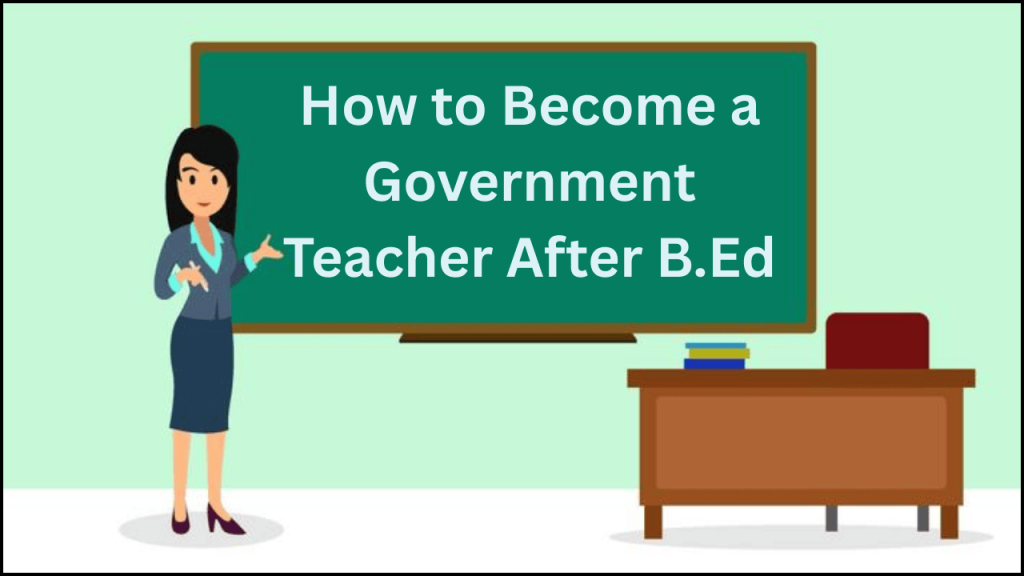
Becoming a government teacher is a dream for many in India, and earning a B.Ed (Bachelor of Education) degree is a key step toward making that dream come true. Government teaching jobs offer job stability, decent salaries, and long-term benefits such as pensions, making them some of the most sought-after careers in the education sector.
If you’ve completed your B.Ed or are planning to pursue it soon, this detailed guide will walk you through the step-by-step process to become a government teacher in 2025.
Step 1: Understand the Eligibility Criteria
Before diving into exams or applications, it’s essential to know the basic eligibility requirements to become a government school teacher in India:
- Educational Qualification: A Bachelor’s degree + B.Ed from a recognized university
- Minimum Marks: Usually 50% in graduation and B.Ed (relaxations for reserved categories)
- Age Limit: Varies by state and recruitment level (usually 18–40 years, with age relaxations for SC/ST/OBC/PWD)
Some central or state-level teaching posts may also require a postgraduate degree, especially for PGT (Post Graduate Teacher) roles.
Step 2: Choose Your Teaching Level
Government schools in India hire teachers at different levels based on qualifications:
- Primary Teacher (PRT): Teaches Classes I to V
→ Requires D.El.Ed or B.Ed + relevant TET qualification - Trained Graduate Teacher (TGT): Teaches Classes VI to X
→ Requires Graduation + B.Ed + TET - Post Graduate Teacher (PGT): Teaches Classes XI and XII
→ Requires Post-graduation + B.Ed + TET
Based on your educational background and interest, decide which level you want to apply for.
Step 3: Qualify in TET or CTET Exam
To become eligible for any government teaching post, passing the Teacher Eligibility Test (TET) is mandatory.
Types of TET Exams:
- CTET (Central Teacher Eligibility Test): Conducted by CBSE for central government schools (e.g., Kendriya Vidyalayas, Navodaya Vidyalayas)
- State TETs (e.g., UPTET, HTET, REET): Conducted by individual state boards for state-level government schools
TET Exam Structure:
- Paper I: For Primary Teachers (Classes I-V)
- Paper II: For Upper Primary Teachers (Classes VI-VIII)
- You can appear for both papers if you wish to teach across multiple levels
TET scores are valid for a lifetime (as per the latest update), and securing a minimum of 60% marks generally qualifies you.
Step 4: Apply for Government Teacher Vacancies
Once you’ve cleared the TET, the next step is to apply for government teaching posts as and when they are announced.
Where to Find Vacancies:
- Central Government: Jobs in Kendriya Vidyalaya Sangathan (KVS), Navodaya Vidyalaya Samiti (NVS), and Army Public Schools
- State Government: Jobs in state-run schools, municipal schools, and Zila Parishad schools
How to Apply:
- Keep an eye on notifications from government job portals, official education department websites, and employment news
- Fill out the application form with your educational details, TET score, and other required documents
- Pay the application fee (if applicable) and submit before the deadline
Step 5: Prepare for the Written Exam (if applicable)
Many government teacher recruitments include a written test even after TET. This exam usually tests your knowledge in:
- General Knowledge & Current Affairs
- Child Pedagogy and Educational Psychology
- Subject-Specific Knowledge
- Teaching Methodology
- Reasoning and Language Proficiency
Pro Tip:
Start your preparation early using NCERT books, TET guides, and the previous year’s papers. Many online platforms also offer mock tests and crash courses tailored for these exams.
Step 6: Attend the Interview or Document Verification
If you clear the written test, you may be called for:
- Interview/Personality Test (especially for PGT/TGT roles)
- Document Verification: Carry original and photocopies of your certificates, TET result, ID proof, caste certificate (if applicable), and passport-size photos
Based on your total score (written + interview), a final merit list will be published.
Step 7: Receive Appointment Letter and Join
Once you’re selected, you’ll receive an appointment letter from the respective department or school. This letter will include your job location, joining instructions, and salary details.
Onboarding Includes:
- Medical check-up (in some states)
- Probation period (typically 2 years)
- Orientation or induction training
Congratulations! You’re now officially a government school teacher.
Bonus Tips for Aspiring Government Teachers
- Stay Updated: Follow exam notification portals and Telegram groups related to teacher recruitment
- Improve Teaching Skills: Attend workshops, webinars, and teacher training programs to stay ahead
- Build a Strong Profile: Certifications in computer literacy, child psychology, or inclusive education add extra value
- Be Patient and Consistent: Government jobs may take time, but perseverance always pays off









